I love pickled ostrich fern fiddleheads, and my recipe for crisp vinegar fiddlehead pickles is one of the most popular recipes on this site (if you're not a fermenter, try those first). I love the old pickles too, and by old I mean naturally fermented pickles. These ones are made from fiddlehead ferns.
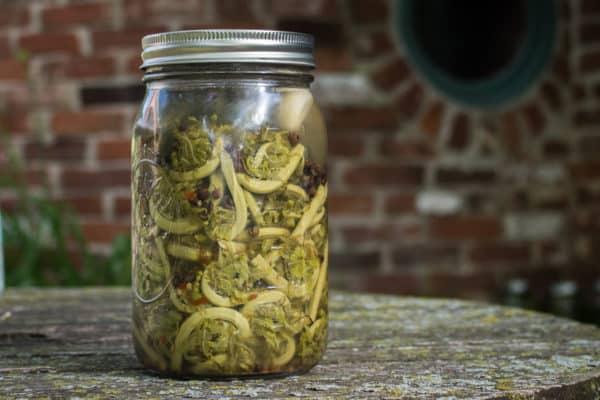
I'd tried fermenting ostrich fiddleheads before, and, unfortunately my failures poisoned my ambition to try them again for a few years.
The problem was that the fiddles got soft, which, along with horrible swamp flavors some plants make (watercress, cow parsnip) can be the bane of many lacto-fermented plants.
After my knotweed pickles turned out so good (thanks to my friend Jacqui over in France for turning me onto that) I decided to turn my attention back to the fiddleheads and give them another go. Fermenting fiddlehead ferns is a little different than knotweed though, since, unlike the bamboo-ey shoots, fiddleheads need to be blanched in boiling water before pickling or suspending in liquid, since otherwise they'll give off an ugly looking black water, and could turn black themselves.
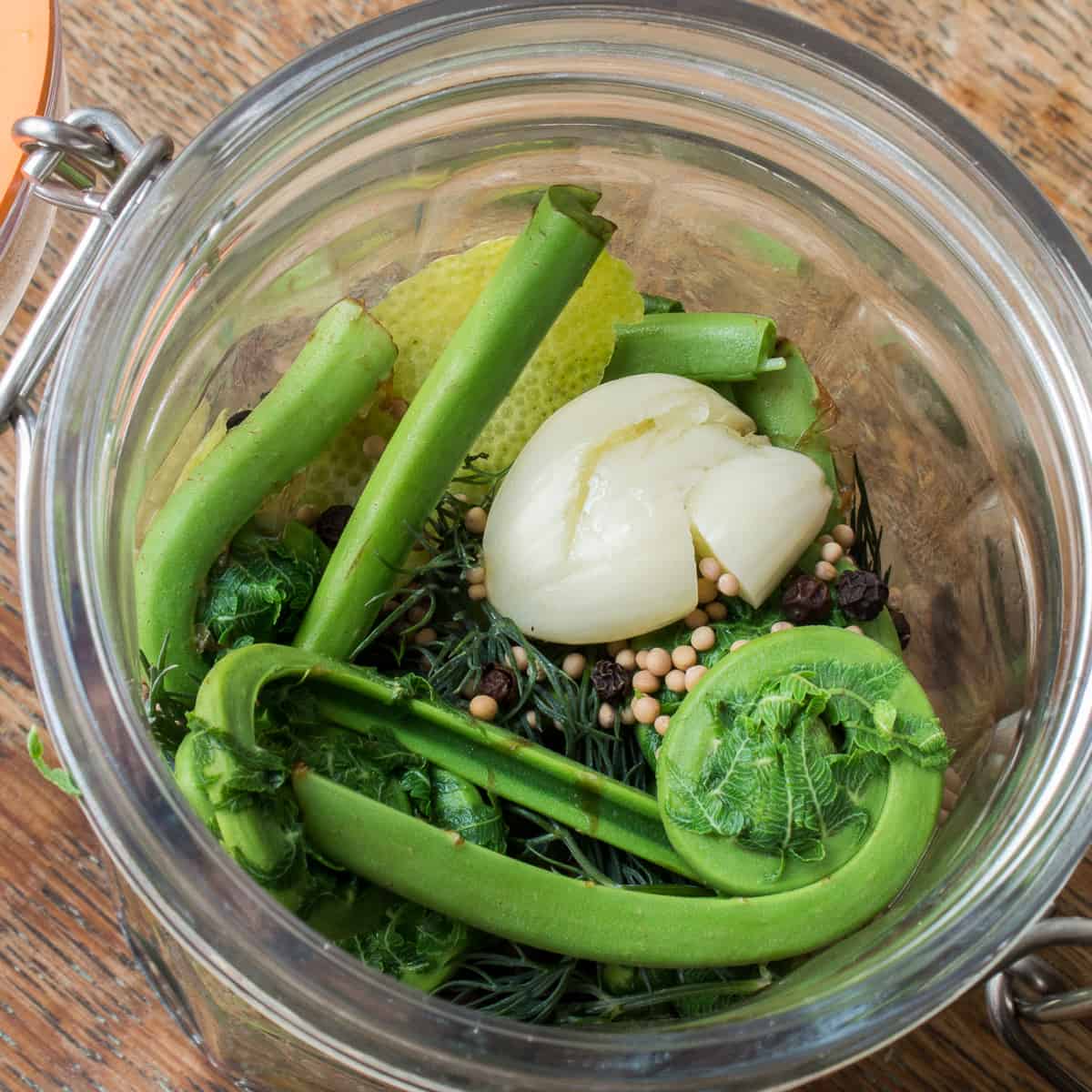
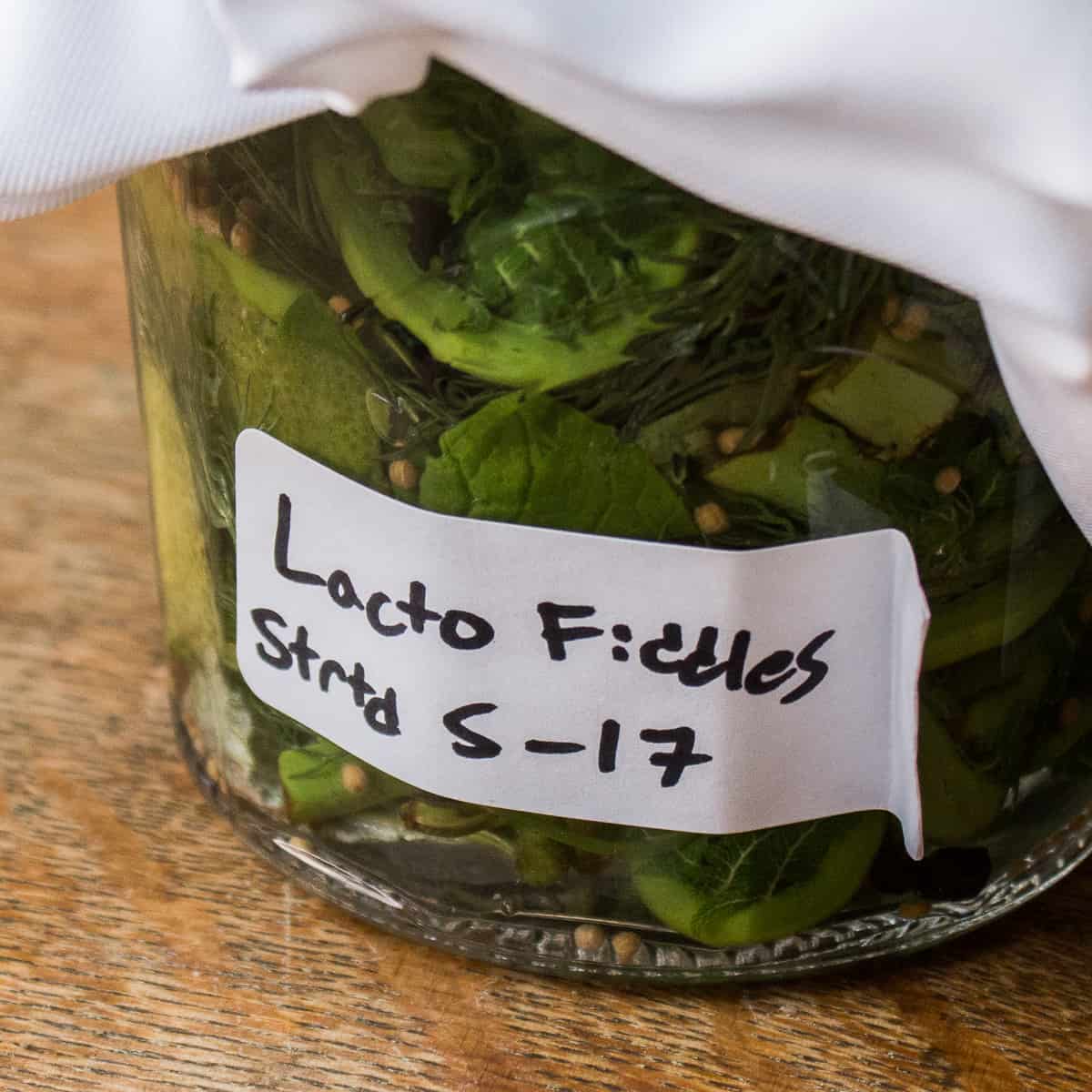
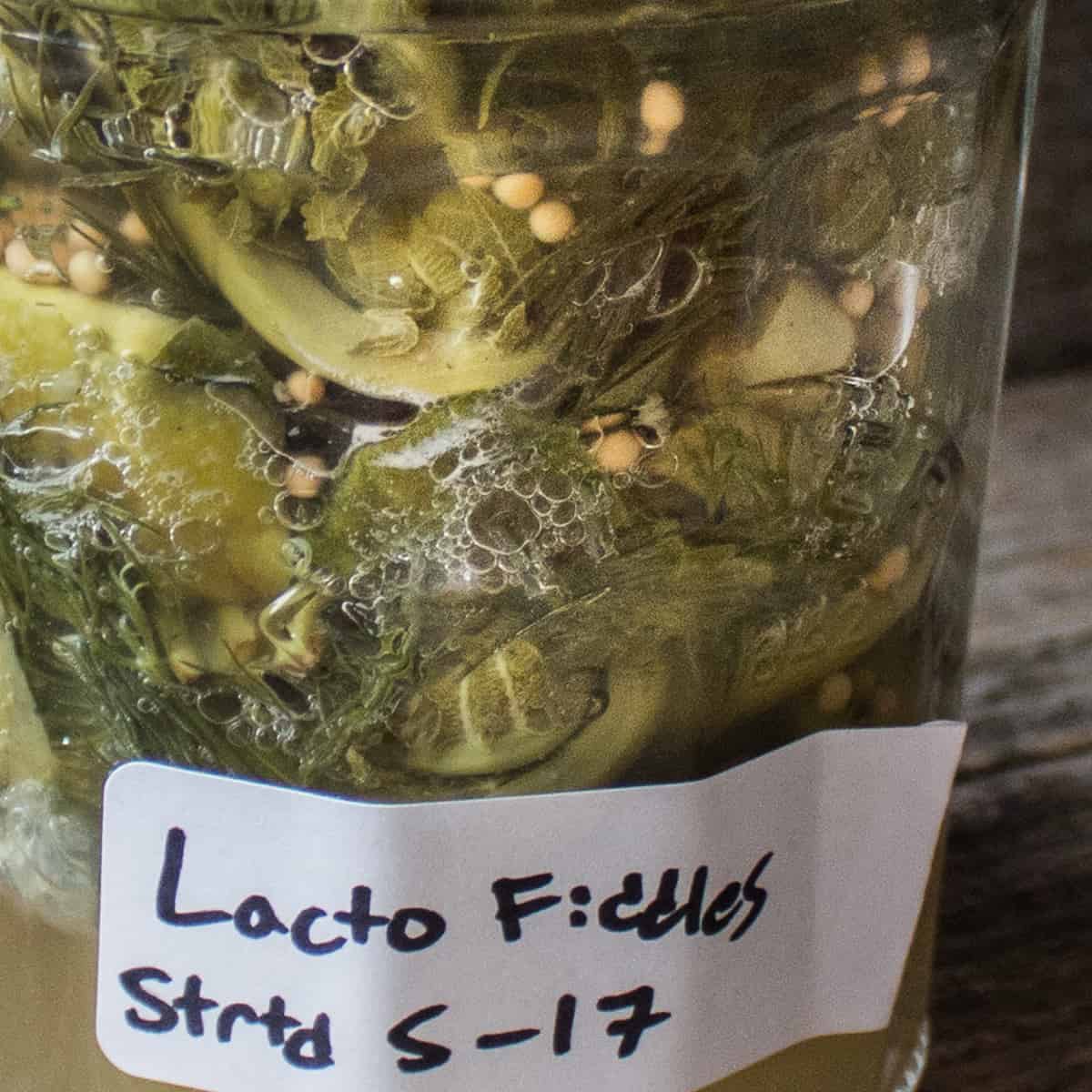
Blanch those fiddles
The issue of how long to blanch fiddleheads comes in to play here. How long is enough? Is a shorter amount of boiling time enough to detoxify them?-- (basically a non-issue with ostrich fern fiddles from my experience, but one worth mentioning as the "folk wisdom" surrounding them is pervasive). Here's the scoop: if you blanch fiddleheads and don't shock them, you can get away with one minute. If you shock them, blanch them for 2 minutes.
I blanched my fiddles before too, but unfortunately, like I mentioned, they went soft after a couple days at room temperature. Since they need to be blanched though, and blanching does always soften things a little, I decided to hedge my bet in two different ways:
1.Use enough salt
Most likely the big issue was that I didn't have enough salt in my first couple batches that went soft, so I used the same ratio as my knotweed pickles: 3% salt of the total weight (sans jar), water, fiddles, spices and all.
To get that, you weigh the fiddles and water in the jar they'll ferment in, multiply the amount of grams by .03, and add that amount of salt in grams, dissolve the salt, set it, and forget it. Easy.
2. Add Grape leaves
A bit of folk wisdom that's useful is the use of leaves to ward off softening in ferments. Grape leaves are the most common I know of, but currant leaves (or likely gooseberry as well) and even oak leaves are said to work.
Commercially, alum is sometimes used for the same purpose. For the record, I've only used grape leaves, but I've used them often, successfully. Not only do the grape leaves help to keep things crisp, but they also seem to ward off some of the pesky yeasts and molds that can develop on the top of the liquid that, if they propagate enough, give off flavors to finished product.
In the end, I can't tell you for certain what the victorious addition was, but it works, so I'm making it live. It's been a month now and my lacto fiddle pickles are still as crisp as when I put them in there, so that's good enough for me.
They won't be exactly like other lacto pickles though, the grape leaves (or something else) seems to slow some of the souring quality compared to other things I've made so the first thing you'll taste is a salty, briny fiddle, but it's a crisp one.
They're especially good with fish, cheese and charcuterie plates. Good on a sandwich too.
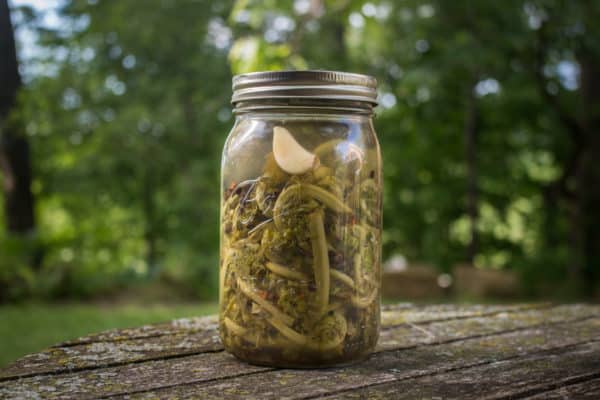
Lacto-Fermented Fiddlehead Ferns
Equipment
- 1 quart mason jar--wide mouth
Ingredients
- Young firm ostrich fiddleheads, tightly coiled, enough to fill a quart jar
- Fine salt or kosher salt (fine salt dissolves quicker) see note
- 2 fresh grape leaves
- A few sprigs of fresh dill
- A pinch of crushed red pepper or a dried chili or two optional
- A clove of garlic
- 1 inch peel of lemon zest optional
- 1 teaspoon black peppercorns
- 1 teaspoon mustard seeds optional
- Water
Instructions
- Clean the fiddleheads and trim the stems. If needed, rinse them to remove any remainder of brown husk. If you have long stems, and want to add them, cut them into lengths about the same size as the croziers (fiddleheads).
- Blanch the fiddleheads and garlic (garlic will discolor eventually and turn blue, but this is purely aesthectic) and stems if using for exactly one minute at a rapid boil, then remove and spread out on a cookie sheet, allowing to cool naturally.
- Toast the peppercorns and mustard seed.
Measure your salt (optional)
- Tare your scale to zero, weighing in grams. Put the jar on the scale. Pack the garlic and fiddleheads into the quart jar, along with the seeds, dill and lemon, then add water until It completely covers the fiddleheads. Take the total weight of the ingredients, multiply it by .03, then add that many grams of salt. Put the lid on the jar and shake well to help the salt distribute, and continue until most of it is dissolved.
- If you don’t want to weigh your salt, just add 1.5 tablespoons. Learning to weigh things to ferment them at a specific percentage of salt is a useful, easy to learn skill though, just sayin.
- Put the grape leaves in the top of the jar, then put a small rock on top to hold everything in place. If you filled it full and water sloshes out, it’s ok.
- Allow the mixture to ferment at room temperature for a few days (with the jar placed in a larger container to catch any migrating liquid) or until you notice visible fermentation. When you like the flavor, refrigerate them if you want.


Dave Vandalay
Do you use tap water or distilled? I read that the chlorine in tap water kills off good bacteria and can prevent proper fermentation. Any truth to this?
Isaac Willis
These are delicious! I made 3 pints and I've given a bunch away to rave reviews. All I didn't have was the mustard seed. I managed to find some tiny shoots of wild grapevine leaves and put a few of them on top. They withered away and got all funky but the fiddleheads are perfect and seem to improve with time in the fridge.
I'll be using the grapeleaves on all my pickles this year.
Incidently, I tried putting a five gallon bucket of grapeleaves under my squash and zuchinni plants about a month ago and I've seen an almost complete erradication of powdery mildew. Again the grape leaves seem to dissolve and disappear.
Love your site. You totally got me foraging and I have lived on wild mushrooms and plants for several years now. I've learned to absolutely love it when it pours down rain. Thanks, Man!
Laura
How much alum would you recommend trying in this recipe instead of grape leaves?
Alan Bergo
I don't know I've never used it.
Craig Carlson
Alan
Have you or your colleagues come up with a method and solution to keep the vibrant green color to the fiddleheads either in the lacto-fermentation or the canned/ refrigerator recipes? Blanching and a quick ice bath holds that color beautifully initially but then (as far as your and most other people’s photos indicate) they turn into that pale dull off putting unappealing hue. Any recommendations would be greatly appreciated. Thanks.
Keep up with your great work!
Regards
Craig Carlson
Alan Bergo
Hi Craig. With pickles and ferments, you're exposing the ferns to acid, so they will never stay green.
Anastasia Teterichko
What about using whey? My mother takes the grass fed milk I give her and leaves it out in the counter to sour for cheese. I take the water that forms and use it in my ferments. I don’t need to add any salt and things ferment in just a few days.
Alan Bergo
You can add whey, and it will speed it up, but you also need to add salt here.
Melody
For the grape leaves, does it matter if they are already fermented? As in should I only be using fresh grape leaves?
Alan Bergo
If you have fermented grape leaves that have not been heated to kill the Lactobasilii you could use them, you could also try using young oak leaves.
Jacqui
So ... I am intrigued by your reference to "horrible swamp flavors some plants make (watercress, cow parsnip) [that] can be the bane of many lacto-fermented plants". "Horrible swamp flavors"? "Watercress, cow parsnip"? Really?
I had been about to write to tell you to add peeled cow parsnip flowering stalks to the list of "things to lacto-ferment because they are really good" as soon as the plants start bolting but now I am worried about my credibility. I made a jar of cow parsley, Anthriscus sylvestris, flowering stalk pickles about a month ago (v.g.) and I have made lots of hogweed (Heracleum sphondylium) flowering stalk pickles in the past but they are not bolting yet. Not swampy at all. And I use watercress, especially the juicy stems, in my kimchi all the time. OK ... it's kimchi. It's kind of funky-swampy by nature, so maybe that removes the problem.
what gives?? I will NOT mail you any pickles to try to prove my point. That's almost sure to go terribly wrong ... hmm ... though I have almost unlimited access to double threaded polypropylene tubes that can withstand high speed centrifuges and -80° freezers. Maybe they could hold some pickles for a week or so without leaking or exploding...
Alan Bergo
Hey Jacqui,
So after I read about the traditional borcht being made with cow parsnip I was really excited to try it. I fermented them a number of different ways trying to get a recipe I liked for my book. I was harvesting the shoots with small-ish leaves attached. I assumed, and I stress assumed here, that the cow parsnip fermentation was done as a preservative method, and in order for it to be shelf stable it would need to be fermented to maximum volume, that is a full two weeks to get a low pH. Everytime I fermented them alone like that it was just awful, and my experience is shared by at least two other wild food authors I know of around the country who were trying to recreate a version of the original green borcht.
After talking with the others who were working on it, we kind of came to the conclusion that the shoots must have been fermented for a shorter amount of time, since otherwise they were not palatable. Your experience is really helpful here, since if the shoots are pleasant after a nice long ferment, it could very well be that the shoots were the part of the plant that was used, and not the attached leaves.
As far as watercress, fermented all alone, for two weeks, I found it awful everytime. Shorter ferments like kimchi where it's diluted a bit would be just fine I think. I'll edit my words a bit to try and make that more clear. Thanks for commenting, it's super helpful. I'm going to have to try the shoots all by themselves.